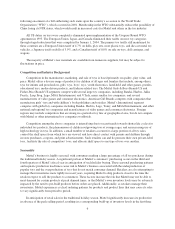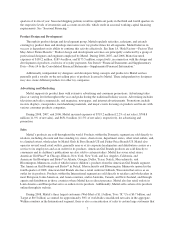Mattel 2008 Annual Report Download - page 19
Download and view the complete annual report
Please find page 19 of the 2008 Mattel annual report below. You can navigate through the pages in the report by either clicking on the pages listed below, or by using the keyword search tool below to find specific information within the annual report.Failure to successfully implement new initiatives could have a material adverse effect on Mattel’s business,
financial condition and results of operations.
Mattel has announced, and in the future may announce, initiatives to reduce its costs, increase its efficiency,
improve the execution of its core business, globalize and extend Mattel’s brands, catch new trends, create new
brands, and offer new innovative products, enhance product safety, develop people, improve productivity,
simplify processes, maintain customer service levels, as well as new initiatives designed to drive sales growth,
capitalize on Mattel’s scale advantage, and improve its supply chain. These initiatives involve investment of
capital and complex decision-making as well as extensive and intensive execution, and the success of these
initiatives is not assured. Failure to successfully implement any of these initiatives, or the failure of any of these
initiatives to produce the results anticipated by management, could have a material adverse effect on Mattel’s
business, financial condition, and results of operations.
Increases in interest rates, reduction of Mattel’s credit ratings, contraction of credit availability or the
inability of Mattel to meet the debt covenant requirements in its credit facilities could negatively impact
Mattel’s ability to conduct its operations.
Increases in interest rates, both domestically and internationally, could negatively affect Mattel’s cost of
financing both its operations and investments. Any reduction in Mattel’s credit ratings could increase the cost of
obtaining financing. Mattel may be hindered from obtaining, or incur additional costs to obtain, additional credit
in light of the current tight credit market environment. Mattel’s domestic credit facility expires on March 23,
2010, and market conditions could affect the size as well as certain terms of the replacement facility.
Additionally, Mattel’s ability to issue long-term debt and obtain seasonal financing could be adversely affected
by factors such as market conditions and an inability to meet its debt covenant requirements, which include
maintaining certain financial ratios. Mattel’s ability to conduct its operations could be negatively impacted
should these or other adverse conditions affect its primary sources of liquidity.
Liquidity problems or bankruptcy of Mattel’s key customers could have a material adverse effect on
Mattel’s business, financial condition and results of operations.
Many of Mattel’s key customers are mass-market retailers. In the past, the mass-market retail channel in the
US has experienced significant shifts in market share among competitors, causing some large retailers to
experience liquidity problems. Certain of Mattel’s customers filed for bankruptcy in 2008 and the recent global
economic crisis has adversely affected the financial condition of most retailers. Mattel’s sales to customers are
typically made on credit without collateral. There is a risk that customers will not pay, or that payment may be
delayed, because of bankruptcy, contraction of credit availability to such customers or other factors beyond the
control of Mattel, which could increase Mattel’s exposure to losses from bad debts. In addition, if these or other
customers were to cease doing business as a result of bankruptcy or significantly reduce the number of stores
operated, it could have a material adverse effect on Mattel’s business, financial condition, and results of
operations.
If Mattel is not able to adequately protect its proprietary intellectual property and information, its results
of operations could be adversely affected.
The value of Mattel’s business depends on its ability to protect its intellectual property and information,
including its trademarks, trade names, copyrights, patents and trade secrets, in the US and around the world, as
well as its customer, employee, and consumer data. If Mattel fails to protect its proprietary intellectual property
and information, including any successful challenge to Mattel’s ownership of its intellectual property or material
infringements of its intellectual property, could have a material adverse effect on Mattel’s business, financial
condition, and results of operations.
15
























